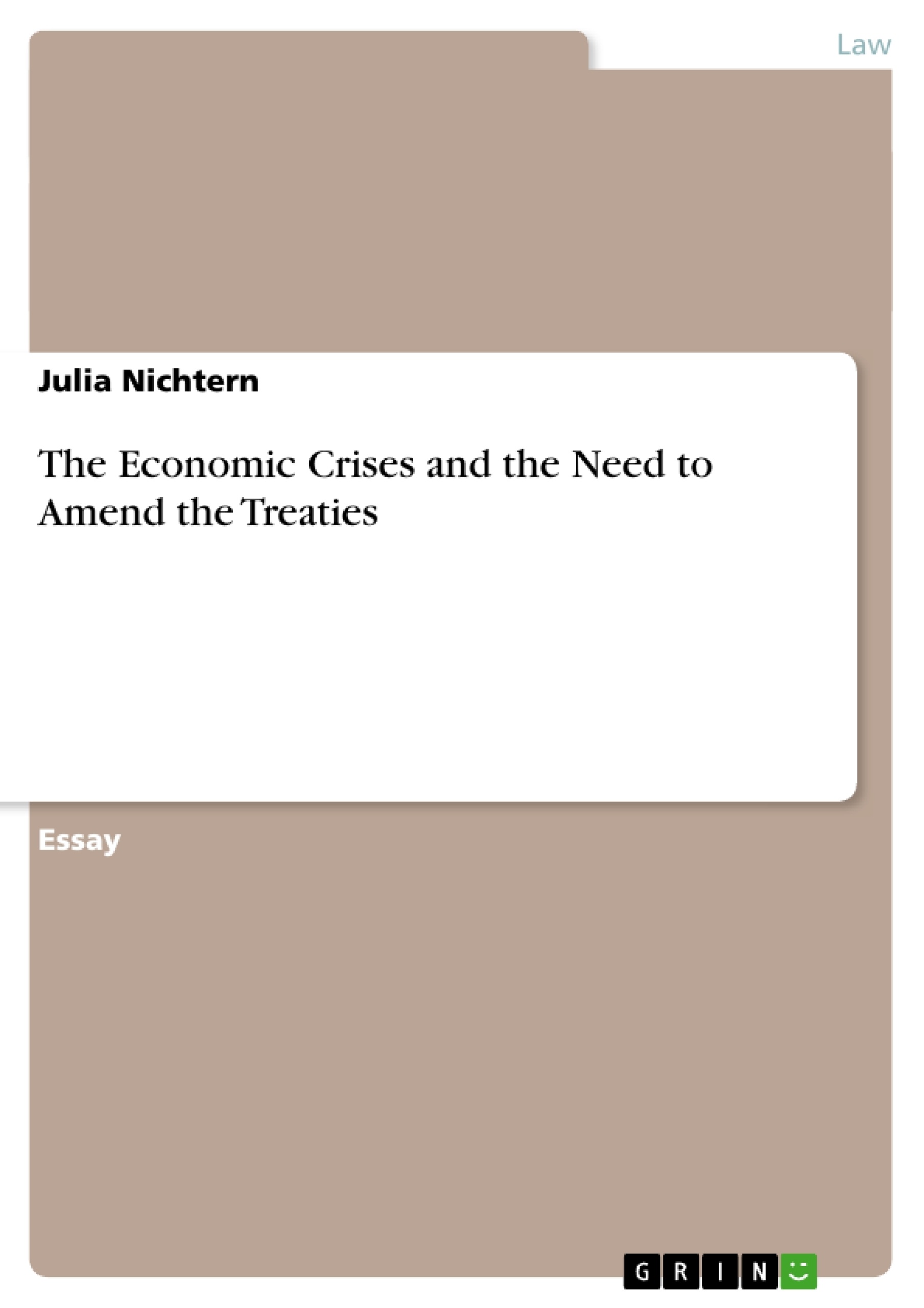The following paper deals with the economic crises and the need to amend the treaty. A short introduction on the origins and the development of the European economic crises will be given, because in order to understand the plans and discussions regarding a treaty amendment and how a treaty amendment can be legally implemented, it is helpful to explain the reasons for such an amendment. Consequently a brief introduction into the development of the economic crises is given. Beside these highly theoretically issues, the paper mainly discusses the question whether there is an acute but mainly a legal need to amend the treaties on the European Union, especially with regard to the current economic situation of the Union and its Member States. Due to the fact that this is a particularly political topic it mainly concentrates on the legal requirements, problems and consequences of a possible treaty amendment. That approach can be justified by the fact that the political matters linked to that topic are almost inexhaustible and would overshadow the legal aspects. But the legal aspects are of great significance, because the planned measures have to comply with EU law and the national laws of the Member States in order to be successfully adopted.
Inhaltsverzeichnis (Table of Contents)
- Abstract
- Introduction
- The Economic Crises – basic information
- Potential procedures for a treaty amendment
- Ordinary revision procedure
- Simplified revision procedure
- The planned amendment
- A legal need to reform the old mechanisms?
- The present state of affairs
- Conclusion
Zielsetzung und Themenschwerpunkte (Objectives and Key Themes)
This paper aims to examine the legal need to amend the Treaty on the European Union, particularly with regard to the ongoing economic crises within the Union and its member states. It explores the origins and development of the crises, the legal basis for treaty amendment, and the planned amendment itself. The key themes discussed in the paper include:- The origins and development of the economic crises, linking the international financial crisis to the crisis within the European Union
- The legal procedures for amending EU treaties, including the ordinary and simplified revision procedures
- The planned amendment to add a new paragraph to Article 136 TFEU, establishing a permanent European Stability Mechanism (ESM)
- The legal implications of the ESM, including its potential to replace existing crisis mechanisms like the EFSF and EFSM
- The potential legal challenges associated with the EFSF and EFSM, focusing on issues like the “no-bailout” rule and the role of the European Central Bank.
Zusammenfassung der Kapitel (Chapter Summaries)
- Abstract: This section provides a brief overview of the paper's content, focusing on the need to amend the EU treaties in light of economic crises and exploring the legal aspects of such an amendment.
- Introduction: This section outlines the paper's structure and sets the stage for the discussion by highlighting the key questions: whether there is a legal need to amend the EU treaties and how such an amendment could be implemented. It also establishes the link between the global financial crisis and the crisis in the European Union.
- The Economic Crises – basic information: This section provides a comprehensive overview of the origins and development of the economic crises, focusing on the events leading to the international financial crisis of 2008 and its subsequent impact on the European Union, specifically on certain eurozone states. It discusses the factors contributing to the crisis, including sub-prime mortgages, the role of investment banks, and the response of governments.
- Potential procedures for a treaty amendment: This section delves into the legal framework for amending EU treaties. It explains the Lisbon Treaty's impact on Article 48 TEU, introducing new procedures for treaty amendments. The section analyzes the ordinary revision procedure and the simplified revision procedure, detailing their steps and requirements.
- The planned amendment: This section focuses on the proposed amendment to Article 136 TFEU, aiming to establish the European Stability Mechanism (ESM). It describes the key features of the ESM, its potential role in addressing economic crises, and its timeline for implementation.
- A legal need to reform the old mechanisms?: This section examines the existing crisis mechanisms, the EFSM and the EFSF, and assesses the legal need for a new mechanism like the ESM. It analyzes the potential legal challenges associated with the existing mechanisms, focusing on issues like the “no-bailout” rule and the role of the European Central Bank.
- The present state of affairs: This section summarizes the current state of the treaty amendment process, discussing the European Council's involvement, the consultation process with EU institutions, and the potential implications for non-eurozone Member States. It also outlines the potential implementation timeline for the ESM and its anticipated legal status as an intergovernmental organization.
Schlüsselwörter (Keywords)
This paper delves into the legal aspects of amending EU treaties in response to economic crises. It explores the origins of the crisis, the legal framework for treaty amendment, and the proposed establishment of the European Stability Mechanism. Key themes include: EU law, economic crises, treaty amendment, financial stability, European Stability Mechanism, EFSM, EFSF, “no-bailout” rule, European Central Bank.- Arbeit zitieren
- Julia Nichtern (Autor:in), 2012, The Economic Crises and the Need to Amend the Treaties, München, GRIN Verlag, https://www.hausarbeiten.de/document/215154


